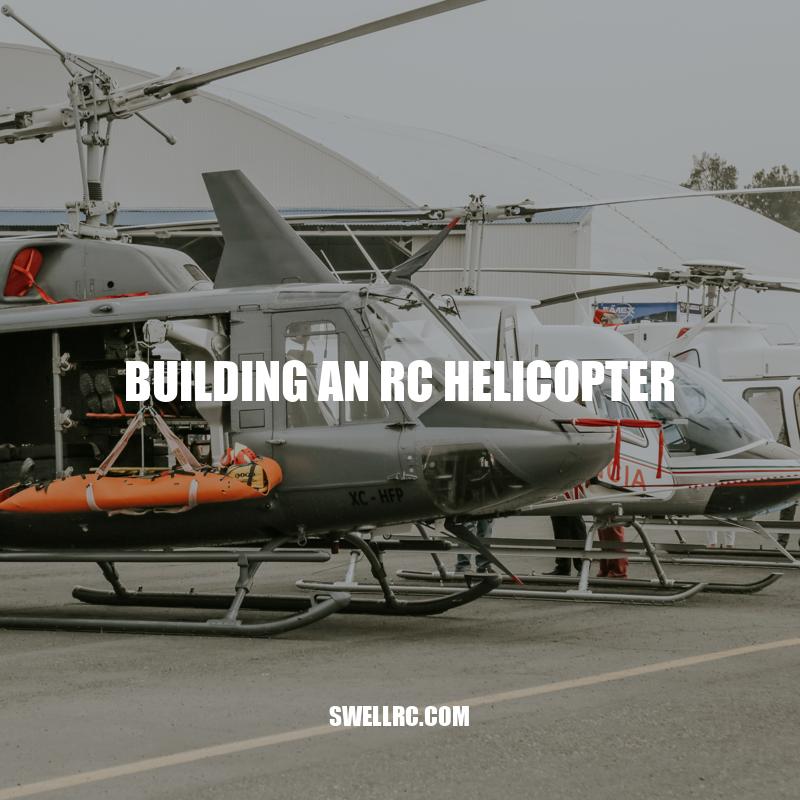Building Your Own RC Helicopter: Essential Tips and Steps for Success
Building an RC helicopter is no small feat – it requires a considerable amount of patience, time, and precision. However, the rewards that come with successfully completing your own RC helicopter build are many. Not only do you get to enjoy the satisfaction of having created something with your own hands, but you also have the opportunity to customize your helicopter to your liking. Building an RC helicopter also gives you a deeper understanding of the mechanics behind this fascinating hobby, which can help you diagnose and fix issues when they arise. Additionally, building your own RC helicopter can be a cost-effective way to enter the hobby, as pre-built models can be expensive. In this guide, we will discuss the different types of RC helicopter kits available, the essential tools required for the build, step-by-step instructions for the build process, as well as tips for successful flight testing, maintenance, and repairs. Whether you are an experienced hobbyist or a beginner looking to enter the world of RC helicopters, this guide will provide you with the information you need to successfully build your own RC helicopter.
Types of RC Helicopter Kits
When it comes to building an RC helicopter from scratch, you have a few options to choose from. Some kits will require more experience and skill to assemble while others are perfect for beginners. The type of kit you choose will vary depending on your level of experience, your budget, and the type of helicopter you want. Here are the different types of RC helicopter kits available:
- Pre-built kit – These kits require the least amount of assembly and are ready to fly out of the box. However, they are often more expensive than other types of kits.
- ARF kit (Almost Ready to Fly) – This type of kit typically requires some assembly, but the main components are already in place. The ARF kit is ideal for intermediate users who want to customize their helicopter.
- Building kit – This kit requires the most amount of assembly work and is perfect for advanced users who want more control over the build process. It’s also the most cost-effective way to enter the hobby.
There are many websites and stores that sell RC helicopter kits, and it can be overwhelming to know where to start. Some good options to consider include Amazon, Horizon Hobby, and Tower Hobbies. It’s essential to do your research before purchasing a kit to make sure you are getting the right one for your skill level and budget. You can also join online forums, such as RC Groups, to learn from experienced hobbyists and get recommendations on the best kits to buy.
What RC helicopter is best for beginner?
If you are a beginner looking for an RC helicopter, it is recommended to start with a simple and easy-to-use model. Here is a list of some of the best RC helicopters for beginner:
| RC Helicopter | Features |
|---|---|
| Syma S107G | Easy to use and control, affordable, durable |
| Blade mCX2 | Stable hovering, lightweight, excellent battery life |
| Hubsan X4 H107L | Compact, precise control, agile and responsive |
There are also many websites providing detailed information and reviews on RC helicopters suitable for beginners, such as RC Helicopter Guide, RC Geeks, and RC Planet. Be sure to do your research before making a purchase to ensure that the helicopter meets your needs and skill level.
Essential Tools for Building an RC Helicopter
To build an RC helicopter, you’ll need some specialized tools. Here are some of the essential tools required to assemble an RC helicopter kit:
- Screwdrivers: You’ll need screwdrivers of different sizes and types to tighten screws and bolts.
- Pliers: Pliers are useful for bending wires, holding small parts, and tightening nuts.
- Hex wrenches: You’ll need hex wrenches of different sizes to tighten hex screws, which are common in RC helicopters.
- Hobby knife: A sharp hobby knife is useful for cutting plastic and other materials.
- Needle-nose pliers: These pliers are ideal for reaching into tight spaces and holding small parts.
- Soldering iron: You’ll need a soldering iron to solder wires and components together.
It’s important to invest in quality tools to ensure a successful build. High-quality tools will last longer and perform better, making your building process smoother. While building an RC helicopter can be an enjoyable hobby, it can also be frustrating if you don’t have the right tools.
Once you have your tools, make sure to keep them organized to prevent misplacing them. You can use a toolbox or a dedicated storage area to keep everything in one place. Some online stores sell toolsets specifically designed for building RC helicopters, which can be a convenient option for beginners who aren’t sure what tools they need.
Building an RC helicopter requires specialized knowledge and tools. Having the right tools can make the process easier and ensure that your helicopter is built correctly. Be sure to invest in quality tools and keep them organized to make the building process smoother. Check out Horizon Hobby for more information on building an RC helicopter and for high-quality tools and kits.
What materials are used to make a RC helicopter?
The most common materials used to make remote control (RC) helicopters are plastic, carbon fiber, aluminum and titanium. The body of the helicopter is made from plastic, while the rotor blades are made of carbon fiber or plastic. The landing gear and frame of the helicopter are made from either aluminum or titanium. Some advanced RC helicopters also feature metal gears and bearings to ensure durability and smooth operation.
For those looking to purchase an RC helicopter, websites such as Horizon Hobby and Amazon offer a wide selection of models made from various materials. It’s important to consider the material quality and durability when choosing an RC helicopter that best suits your needs.
| Materials | Usage |
| Plastic | Body |
| Carbon fiber or plastic | Rotor blades |
| Aluminum or titanium | Landing gear and frame |
| Metal gears and bearings | Durability and smooth operation |
- Horizon Hobby (https://www.horizonhobby.com/)
- Amazon (https://www.amazon.com/)
Steps to Building an RC Helicopter
Building an RC helicopter can be a complex process, but following these steps can help make it less intimidating:
- Step 1: Read the manual thoroughly before starting the build. Make sure you understand all the instructions and have all the necessary parts and tools.
- Step 2: Lay out all the parts on a clean, flat surface. This will make it easier to keep track of everything and prevent parts from rolling away.
- Step 3: Start assembling the frame of the helicopter. Make sure all pieces are secured tightly and aligned properly.
- Step 4: Attach the motor and other electronic components to the frame, following the instructions carefully.
- Step 5: Install the blades and other rotor components. Make sure they are properly balanced and aligned.
- Step 6: Connect all the wiring and test the electronics to make sure everything is working properly.
- Step 7: Finally, test the helicopter to make sure it flies properly and make any necessary adjustments.
It’s important to take your time with each step and double-check everything as you go. If you get stuck or have questions, don’t hesitate to reach out to the manufacturer or consult online forums and resources. Some popular websites offer tutorials, videos, and support on building RC helicopters, such as heliguy.com, rcgroups.com, and hobbyking.com.
What is different about RC helicopter?
RC helicopters, which are also known as radio-controlled helicopters, are different from traditional toy helicopters in a number of ways:
| Traditional Toy Helicopters | RC Helicopters |
|---|---|
| Simple controls | Advanced controls |
| Battery-powered | Can be battery or gas-powered |
| One or two-channel | Four to six-channel |
| Low cost | Higher cost due to advanced features and materials used |
RC helicopters are designed for hobbyists and enthusiasts who want to fly a more advanced remote-controlled vehicle. They have more advanced controls than traditional toy helicopters, including a greater range of movements and the ability to hover in place. RC helicopters can also be battery or gas-powered, giving them more endurance and the ability to fly for longer periods of time.
If you are interested in purchasing an RC helicopter, there are many websites and products available to help you get started. Some popular websites include RC Planet, Horizon Hobby, and Tower Hobbies. These websites offer a wide range of RC helicopters and other remote-controlled vehicles, as well as parts and accessories to help you maintain and repair your helicopter.
Building an RC Helicopter
If you’re interested in building an RC helicopter, there are a few things you’ll need to consider. First, you’ll want to decide on the type of helicopter you want to build. There are many different models available, ranging from beginner-friendly options to more advanced models.
RC Helicopter Kits
One option is to purchase an RC helicopter kit. These kits come with all the necessary parts and instructions to build your own helicopter. Some popular brands include Horizon Hobby and Align.
Building from Scratch
If you’re more adventurous, you can also build an RC helicopter from scratch. This will require more skill, time, and effort, but can be a rewarding experience. There are many resources available online, including step-by-step guides, forums, and YouTube tutorials.
Tools and Equipment
Regardless of whether you choose to build a kit or from scratch, you’ll need some basic tools and equipment. These may include a soldering iron, pliers, screwdrivers, and wire strippers. Some kits may also require specialized tools or equipment.
Flying Your RC Helicopter
Once you’ve built your RC helicopter, it’s important to test and fly it safely. Here are some things to keep in mind:
- Test all the electronics and controls thoroughly before attempting to fly the helicopter. Make sure everything responds correctly and in the right direction.
- Choose a large, open space without trees, buildings, or other potential obstacles.
- Start with small and low hops to make sure the helicopter is stable and won’t tip over.
- Gradually increase the altitude and distance of the flight as you become more comfortable with the controls.
- Always keep your eyes on the helicopter and avoid flying it near people or animals.
- Remember to recharge or replace the batteries as needed for peak performance.
RC Helicopter Maintenance
Following the instructions on maintaining your helicopter can help extend its lifespan. Some maintenance tips include checking the screws and connectors after each flight, cleaning the dust and debris from the rotor blades, and inspecting the wiring and battery regularly. Various websites offer additional tips for RC helicopter maintenance and flying, such as rcadvisor.com, flyingrc.net, and rcuniverse.com.
Why won t my RC helicopter fly?
There could be several reasons why your RC helicopter won’t fly. Here are some factors you might want to consider:
– Battery issues: Make sure the battery is fully charged and properly inserted into the helicopter.
– Remote control: Check that the remote control is working correctly and is synced with the helicopter.
– Weight: If your helicopter is carrying too much weight, it may not be able to take off. Remove any unnecessary items or consider upgrading the motor and battery.
– Blades: Make sure the blades are attached correctly and aren’t damaged or obstructed in any way.
– Wind: Flying in windy conditions can make it difficult for your helicopter to stay airborne. Choose a calm day to fly.
– Altitude: Higher altitudes require more power to stay airborne. Your helicopter may not have enough power to fly at high elevations.
If you still can’t figure out why your helicopter won’t fly, check your user manual or consult with the manufacturer’s website for troubleshooting tips or customer support.
Building an RC Helicopter
If you’re interested in building an RC helicopter, there are several things to consider. First and foremost, you need to decide whether you want to build your helicopter from scratch or buy a kit. Buying a kit may be easier, especially if you’re new to building RC helicopters.
Here are some tips:
- Research the different types of helicopters available, from beginner to advanced models.
- Choose a reputable brand such as Align or Walkera.
- Consider the type of flying you want to do, such as indoor or outdoor.
- Take time to read reviews and product specifications before making your purchase.
Building Your Helicopter from Scratch
If you want to build your helicopter from scratch, here are some things to keep in mind:
- Tools: You’ll need a range of tools such as screwdrivers, pliers, and wire cutters.
- Parts: Make sure you have all the necessary parts, including the frame, motor, blades, and electronics.
- Assembly: Follow the instructions carefully and take your time to ensure proper assembly.
- Testing: Always test your helicopter before flying it for the first time to avoid accidents.
Flight Control
Flight control is crucial for safely flying your RC helicopter. Here are some things to consider when it comes to flight control:
- Transmitter: Invest in a good quality transmitter such as Spektrum DX6i or Futaba 14SG.
- Gyros: Gyros help stabilize your helicopter during flight and prevent it from drifting off-course. Look for gyros from brands such as ALIGN or Futaba.
- Servos: Servos control the movement of the helicopter’s blades and other parts. Brands such as Spektrum and Futaba offer high-quality servos.
Care and Maintenance
Regular care and maintenance can help prolong the life of your RC helicopter. Here are some tips:
- Cleaning: Regularly clean your helicopter to remove dust and debris.
- Lubrication: Use specialized lubricants, such as those from Dow Corning, to keep your helicopter’s moving parts running smoothly.
- Battery care: Take care of your batteries by using good quality batteries, such as Dromida or Traxxas Power Cell, and replacing them regularly to avoid damage to other components.
- Regular checks: Check for signs of wear and tear, such as cracks on the rotor blades or any looseness in the mechanism. Identify and troubleshoot issues as soon as possible to avoid further damage.
With the right tools, parts, and care, building your own RC helicopter can be a rewarding experience. Always make sure to thoroughly research and plan before starting your build, and take your time during the assembly process.
Do helicopters require a lot of maintenance?
Yes, helicopters require a significant amount of maintenance due to their complex mechanical systems and high-performance components. Regular inspections, component replacements, and lubrication of moving parts are required to ensure their safe operation.
Here are a few examples of the maintenance requirements for helicopters:
| Maintenance Task | Frequency |
|---|---|
| Inspection of rotor blades | Every 100 flight hours or 12 months, whichever comes first |
| Oil changes | Every 50 hours of flight time or as recommended by the manufacturer |
| Overhaul of engine | Every 1,200 hours of flight time or as recommended by the manufacturer |
If you’re interested in learning more about helicopter maintenance, FAA (Federal Aviation Administration) offers resources and guidelines on their website. Additionally, companies like HeliPal provide high-quality helicopter maintenance and repair services for various makes and models.
Conclusion
Building an RC helicopter is a rewarding and exciting journey for anyone interested in the hobby. While it may seem daunting, with patience, attention to detail, and the right tools, it’s certainly achievable. Starting with a basic kit and upgrading it as your skills improve is a great way to start. Remember to always prioritize safety and adhere to any local rules and regulations when flying your helicopter.
Building an RC helicopter also opens up possibilities for customization and experimentation, making the hobby even more enjoyable. The community of RC helicopter enthusiasts is also vast and supportive, offering resources, help, and advice.
If you’re interested in building an RC helicopter, take the leap and give it a try. There’s no better way to learn about RC helicopters than to build and fly your own.



